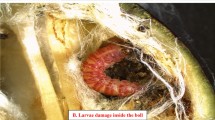Abstract
A field evaluation of nine chemicals was conducted at Cotton Research Station Kibos for their efficacy against bollworm and cotton stainer species attacking cotton in Kenya. Based on the yield and percentage stained seed cotton, Decis/Triazophos, pp 321 Karate and Baythroid and Decis were the most effective insecticides in 1985 and 1986 respectively. However, there was no consistency in results of performance of insecticides tested against cotton insects in the 2 years. The apparent poor performance of most insecticides tested against cotton insects was attributed to fixed insecticide spray schedule which resulted in superfluous and often mistimed chemical applications. It is therefore necessary to establish damaging threshold(s) of major cotton pests in this country so that chemicals can be efficiently used to control them with minimum adverse effects on our environment.
Résumé
Une étude aux champs de l’efficacité de 9 pesticides a été effectué à la Station Kibos Cotton Research sur le ver de la capsule et la punaise qui attaquent le coton au Kenya. En se basant sur le rendement et le pourcentage des graines de coton endommagées. Decis/Triazophos, pp 321 Karate et Baythroid et Decis se sont montrés les insecticides les plus efficaces respectivement en 1985 et 1986. Cependant, l’efficacité de ces insecticides testés sur les ravageurs du coton n’était pas le même pour les deux années. La faible efficacité de la plupart des insecticides testés sur les insectes du coton était due au choix d’un calendrier de traitement ayant un interval fixe. Ce programme de traitement a conduit à un gaspillage de produit et surtout à une mauvaise periode de traitement. Il est alors necessaire d’établir les seuils de dégâts des principaux ravageurs du coton dans le pays, pour que les insecticides peuvent être utilisés à bon escient pour la lutte de ces insectes avec un minimum d’effets néfastes à l’environment.
Similar content being viewed by others
References
Anonymous (1985) The 1985 insecticide/acaricide recommendations for cotton. Circular letter from the senior Entomologist. Kenya Minist. Agric.
Anonymous (1986) The 1986 insecticide/acaricide recommendations for cotton. Circular letter from the Senior Entomologist. Kenya Minist. Agric.
Georghiou G. P. and Taylor C. E. (1977a) Genetic and biological influences in the evolution of insecticide resistance. J. Econ. Ent. 70, 319–323.
Georghiou G. P. and Taylor C. E. (1977b) Operational influences in the evolution of insecticide resistance. J. econ. Ent. 70, 653–658.
Gonzalez R. H. (1976) Insect resistance to pesticides. In Plant Protection Service. Plant Production Division. Lecture Number 17, 138–144, FAO Rome, Italy.
Hall D. C. and Norgaard B. R. (1973) On the timing and application of pesticides. Am. J. Agric. Econ. 55, 198–201.
Little T. M. and Hills F. T. (1977) Agricultural Experimentation: Design and Analysis. John Wiley and Sons. New York.
Mathews G. A. and Tunstall J. P. (1968) Scouting for pests and the timing of spray applications. Cotton Grow. Rev. 45, 115–127.
Mambiri A. M. (1985) Susceptibility of Dysdercus spp. Boisduval (Hemiptera: Pyrrhocoridae) to selected synthetic pyrethroid insecticides. M.Sc. Thesis. University of Nairobi.
Martin H. and Woodcock D. (1983) The Scientific Principles of Crop Protection. Edward Arnold, London.
Murega T. N. and Khaemba B. M. (1985) Evaluation of some chemicals for efficacy against the red spider mites, Tetranychus sp. (Acarina: Tetranychidae) attacking cotton in Kenya. Insect Sci. Applic. 6, 11–15.
Reed W. (1972) Uses and abuses of unsprayed controls in spraying trials. Cotton Grow. Rev. 49, 67–72.
Stern V. M., Smith R. F., Bosch R. and Hagen K. S. (1959) The integrated control concept. Hilgardia 29, 81–101.
Ware G. W. (1978) Pesticides: Theory and Application. W. H. Freeman and Company, San Francisco.
Author information
Authors and Affiliations
Rights and permissions
About this article
Cite this article
Mambiri, A.M., Amadalo, B.A. Field Evaluation of Some Chemicals for Efficacy Against Bollworm and Cotton Stainer Species Attacking Cotton in Kenya. Int J Trop Insect Sci 9, 287–295 (1988). https://doi.org/10.1017/S1742758400006159
Received:
Revised:
Published:
Issue Date:
DOI: https://doi.org/10.1017/S1742758400006159
Key Words
- Synthetic pyrethroid
- threshold
- resistance
- cotton stainers
- Dysdercus species
- African cotton bollworm
- Heliothis armigera
- Decis
- Baythroid
- pp 321 Karate




